brake sensor INFINITI QX56 2007 Factory Owner's Manual
[x] Cancel search | Manufacturer: INFINITI, Model Year: 2007, Model line: QX56, Model: INFINITI QX56 2007Pages: 3061, PDF Size: 64.56 MB
Page 105 of 3061
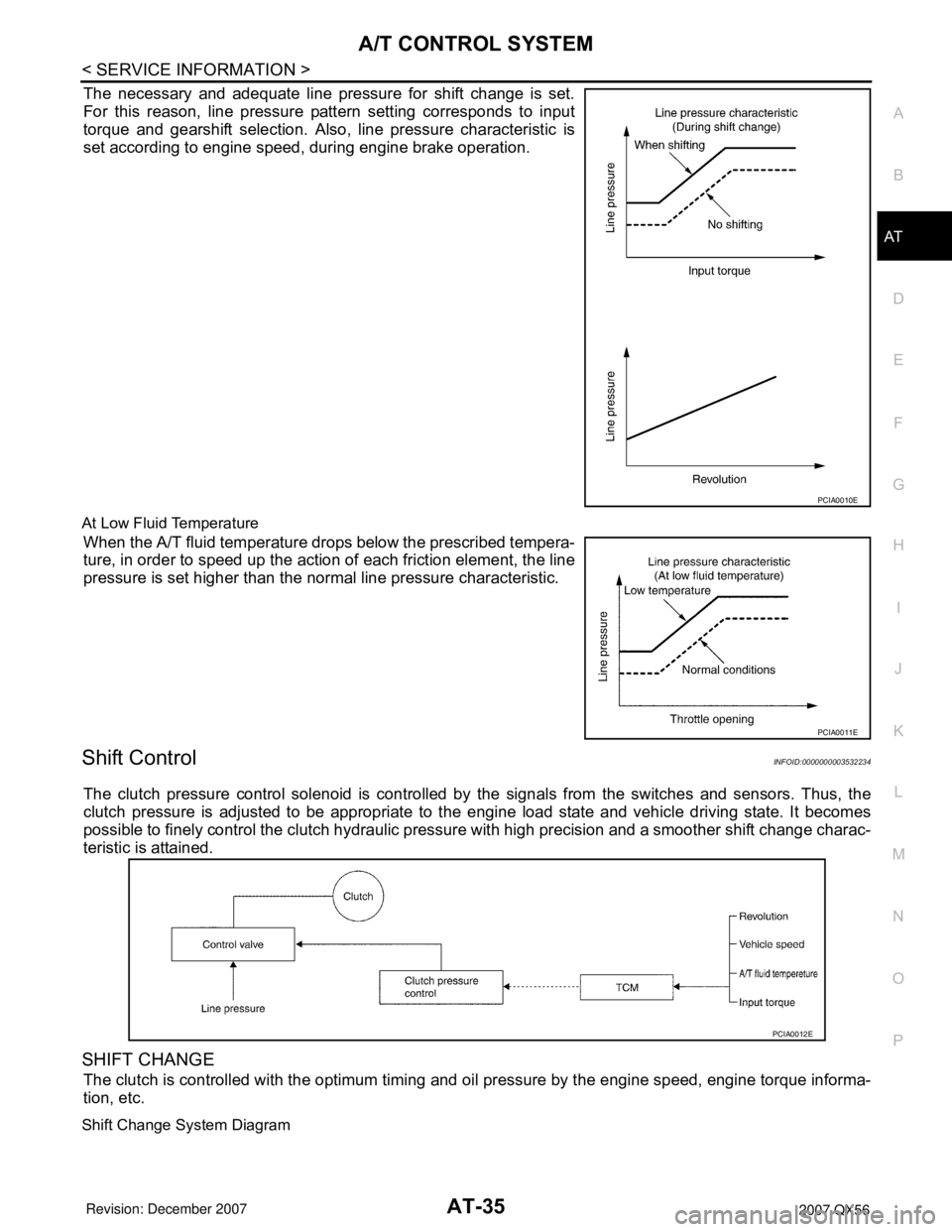
A/T CONTROL SYSTEM
AT-35
< SERVICE INFORMATION >
D
E
F
G
H
I
J
K
L
MA
B
AT
N
O
P
The necessary and adequate line pressure for shift change is set.
For this reason, line pressure pattern setting corresponds to input
torque and gearshift selection. Also, line pressure characteristic is
set according to engine speed, during engine brake operation.
At Low Fluid Temperature
When the A/T fluid temperature drops below the prescribed tempera-
ture, in order to speed up the action of each friction element, the line
pressure is set higher than the normal line pressure characteristic.
Shift ControlINFOID:0000000003532234
The clutch pressure control solenoid is controlled by the signals from the switches and sensors. Thus, the
clutch pressure is adjusted to be appropriate to the engine load state and vehicle driving state. It becomes
possible to finely control the clutch hydraulic pressure with high precision and a smoother shift change charac-
teristic is attained.
SHIFT CHANGE
The clutch is controlled with the optimum timing and oil pressure by the engine speed, engine torque informa-
tion, etc.
Shift Change System Diagram
PCIA0010E
PCIA0011E
PCIA0012E
Page 113 of 3061
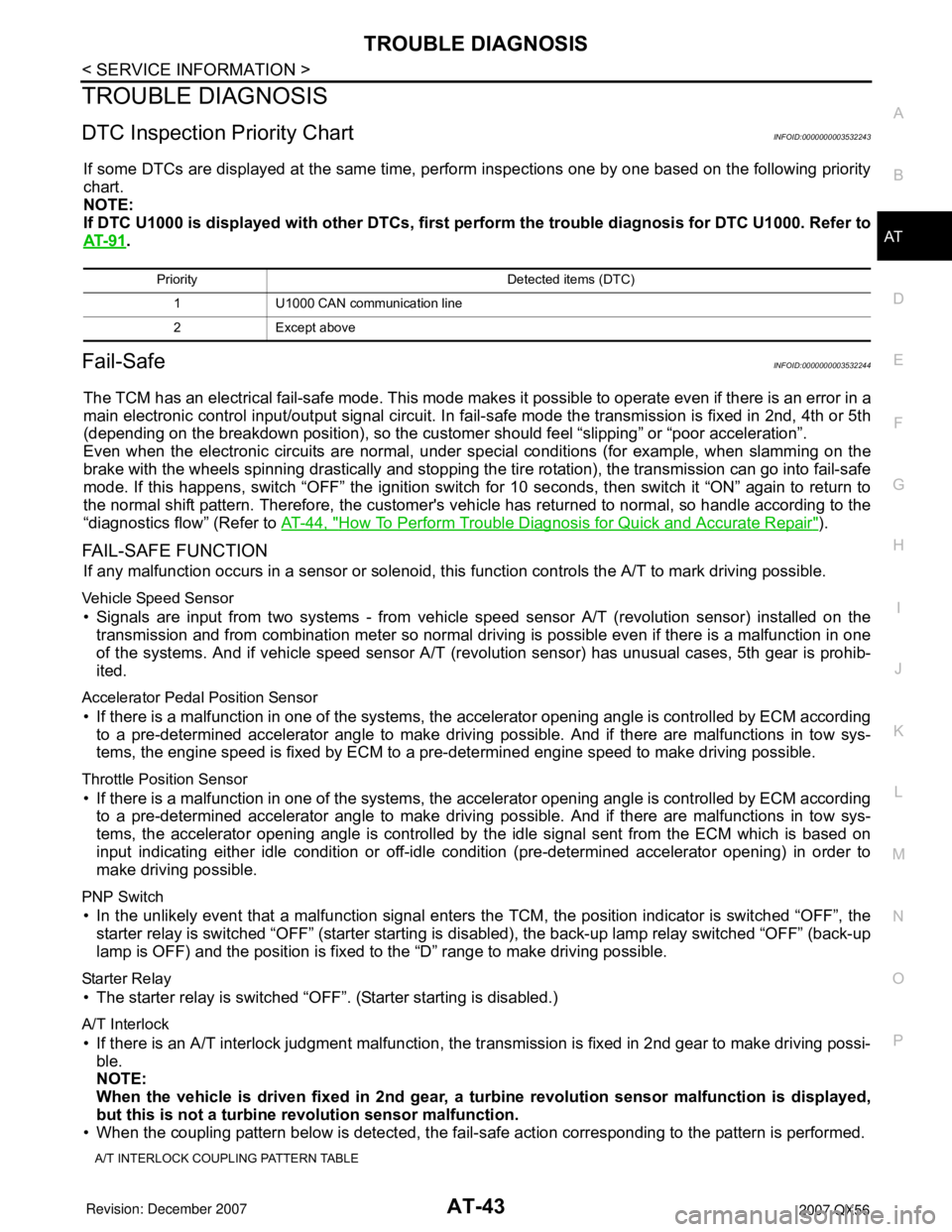
TROUBLE DIAGNOSIS
AT-43
< SERVICE INFORMATION >
D
E
F
G
H
I
J
K
L
MA
B
AT
N
O
P
TROUBLE DIAGNOSIS
DTC Inspection Priority ChartINFOID:0000000003532243
If some DTCs are displayed at the same time, perform inspections one by one based on the following priority
chart.
NOTE:
If DTC U1000 is displayed with other DTCs, first perform the trouble diagnosis for DTC U1000. Refer to
AT- 9 1
.
Fail-SafeINFOID:0000000003532244
The TCM has an electrical fail-safe mode. This mode makes it possible to operate even if there is an error in a
main electronic control input/output signal circuit. In fail-safe mode the transmission is fixed in 2nd, 4th or 5th
(depending on the breakdown position), so the customer should feel “slipping” or “poor acceleration”.
Even when the electronic circuits are normal, under special conditions (for example, when slamming on the
brake with the wheels spinning drastically and stopping the tire rotation), the transmission can go into fail-safe
mode. If this happens, switch “OFF” the ignition switch for 10 seconds, then switch it “ON” again to return to
the normal shift pattern. Therefore, the customer's vehicle has returned to normal, so handle according to the
“diagnostics flow” (Refer to AT-44, "
How To Perform Trouble Diagnosis for Quick and Accurate Repair").
FAIL-SAFE FUNCTION
If any malfunction occurs in a sensor or solenoid, this function controls the A/T to mark driving possible.
Vehicle Speed Sensor
• Signals are input from two systems - from vehicle speed sensor A/T (revolution sensor) installed on the
transmission and from combination meter so normal driving is possible even if there is a malfunction in one
of the systems. And if vehicle speed sensor A/T (revolution sensor) has unusual cases, 5th gear is prohib-
ited.
Accelerator Pedal Position Sensor
• If there is a malfunction in one of the systems, the accelerator opening angle is controlled by ECM according
to a pre-determined accelerator angle to make driving possible. And if there are malfunctions in tow sys-
tems, the engine speed is fixed by ECM to a pre-determined engine speed to make driving possible.
Throttle Position Sensor
• If there is a malfunction in one of the systems, the accelerator opening angle is controlled by ECM according
to a pre-determined accelerator angle to make driving possible. And if there are malfunctions in tow sys-
tems, the accelerator opening angle is controlled by the idle signal sent from the ECM which is based on
input indicating either idle condition or off-idle condition (pre-determined accelerator opening) in order to
make driving possible.
PNP Switch
• In the unlikely event that a malfunction signal enters the TCM, the position indicator is switched “OFF”, the
starter relay is switched “OFF” (starter starting is disabled), the back-up lamp relay switched “OFF” (back-up
lamp is OFF) and the position is fixed to the “D” range to make driving possible.
Starter Relay
• The starter relay is switched “OFF”. (Starter starting is disabled.)
A/T Interlock
• If there is an A/T interlock judgment malfunction, the transmission is fixed in 2nd gear to make driving possi-
ble.
NOTE:
When the vehicle is driven fixed in 2nd gear, a turbine revolution sensor malfunction is displayed,
but this is not a turbine revolution sensor malfunction.
• When the coupling pattern below is detected, the fail-safe action corresponding to the pattern is performed.
A/T INTERLOCK COUPLING PATTERN TABLE
Priority Detected items (DTC)
1 U1000 CAN communication line
2 Except above
Page 114 of 3061

AT-44
< SERVICE INFORMATION >
TROUBLE DIAGNOSIS
l: NG X: OK
A/T 1st Engine Braking
• When there is an A/T first gear engine brake judgment malfunction, the low coast brake solenoid is switched
“OFF” to avoid the engine brake operation.
Line Pressure Solenoid
• The solenoid is switched “OFF” and the line pressure is set to the maximum hydraulic pressure to make driv-
ing possible.
Torque Converter Clutch Solenoid
• The solenoid is switched “OFF” to release the lock-up.
Low Coast Brake Solenoid
• When a (electrical or functional) malfunction occurs, in order to make driving possible, the engine brake is
not applied in 1st and 2nd gear.
Input Clutch Solenoid
• If a (electrical or functional) malfunction occurs with the solenoid either “ON” or “OFF”, the transmission is
held in 4th gear to make driving possible.
Direct Clutch Solenoid
• If a (electrical or functional) malfunction occurs with the solenoid either “ON” or “OFF”, the transmission is
held in 4th gear to make driving possible.
Front Brake Solenoid
• If a (electrical or functional) malfunction occurs with the solenoid “ON”, in order to make driving possible, the
A/T is held in 5th gear; if the solenoid is OFF, 4th gear.
High and Low Reverse Clutch Solenoid
• If a (electrical or functional) malfunction occurs with the solenoid either “ON” or “OFF”, the transmission is
held in 4th gear to make driving possible.
Turbine Revolution Sensor 1 or 2
• The control is the same as if there were no turbine revolution sensors, 5th gear is prohibited.
How To Perform Trouble Diagnosis for Quick and Accurate RepairINFOID:0000000003532245
INTRODUCTION
The TCM receives a signal from the vehicle speed sensor, accelerator pedal position sensor (throttle position
sensor) or PNP switch and provides shift control or lock-up control via A/T solenoid valves.
The TCM also communicates with the ECM by means of a signal
sent from sensing elements used with the OBD-related parts of the
A/T system for malfunction-diagnostic purposes. The TCM is capa-
ble of diagnosing malfunctioning parts while the ECM can store mal-
functions in its memory.
Input and output signals must always be correct and stable in the
operation of the A/T system. The A/T system must be in good oper-
ating condition and be free of valve seizure, solenoid valve malfunc-
tion, etc.
Gear positionATF pressure switch output
Fail-safe
functionClutch pressure output pattern after fail-safe func-
tion
SW3
(I/C)SW6
(HLR/
C)SW5
(D/C)SW1
(FR/B)SW2
(LC/B)I/C HLR/C D/C FR/B LC/B L/U
A/T interlock
coupling pat-
tern3rd – X X – lHeld in
2nd gearOFF OFF ON OFF OFF OFF
4th – X X –lHeld in
2nd gearOFF OFF ON OFF OFF OFF
5th X X – XlHeld in
2nd gearOFF OFF ON OFF OFF OFF
SAT631IB
Page 124 of 3061
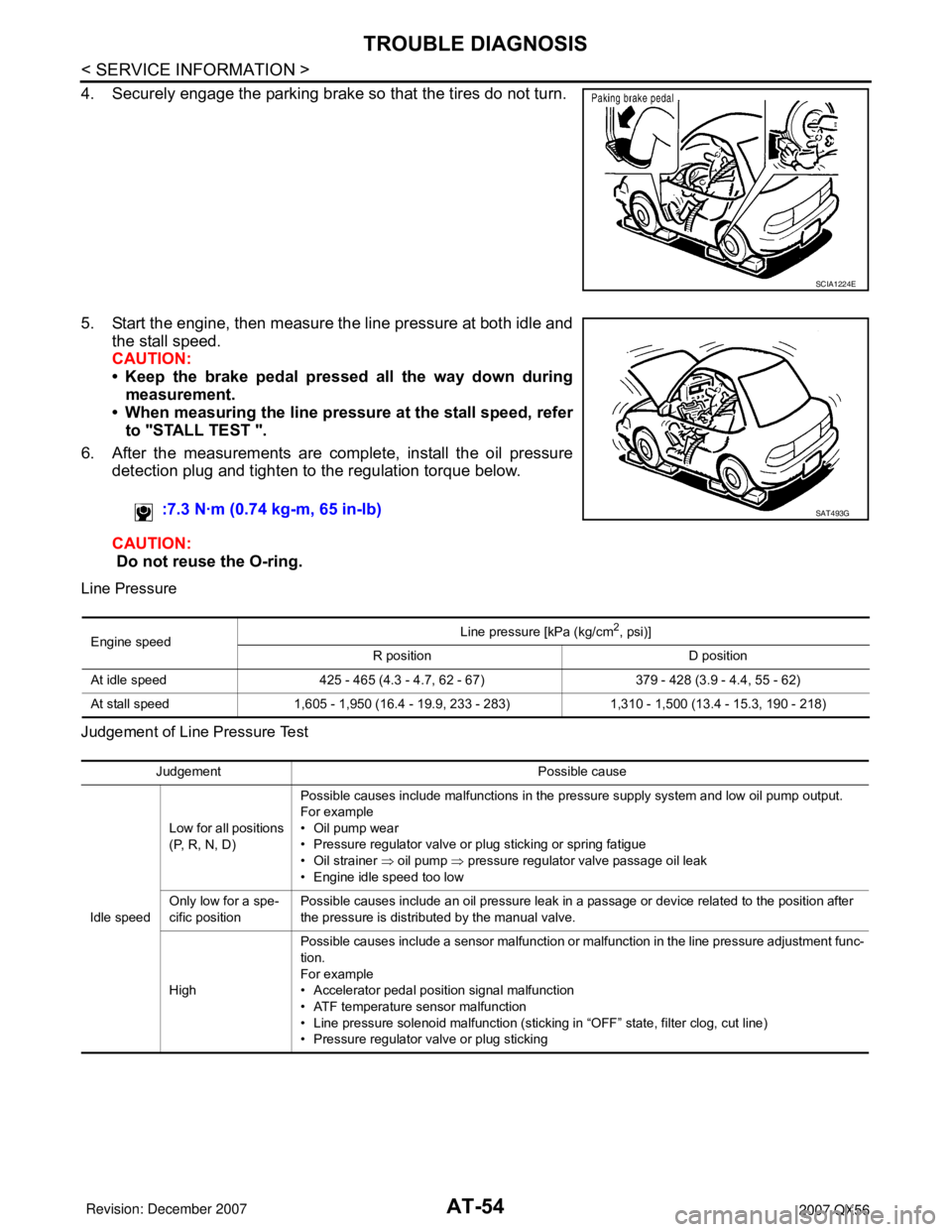
AT-54
< SERVICE INFORMATION >
TROUBLE DIAGNOSIS
4. Securely engage the parking brake so that the tires do not turn.
5. Start the engine, then measure the line pressure at both idle and
the stall speed.
CAUTION:
• Keep the brake pedal pressed all the way down during
measurement.
• When measuring the line pressure at the stall speed, refer
to "STALL TEST ".
6. After the measurements are complete, install the oil pressure
detection plug and tighten to the regulation torque below.
CAUTION:
Do not reuse the O-ring.
Line Pressure
Judgement of Line Pressure Test
SCIA1224E
:7.3 N·m (0.74 kg-m, 65 in-lb)SAT493G
Engine speedLine pressure [kPa (kg/cm
2, psi)]
R position D position
At idle speed 425 - 465 (4.3 - 4.7, 62 - 67) 379 - 428 (3.9 - 4.4, 55 - 62)
At stall speed 1,605 - 1,950 (16.4 - 19.9, 233 - 283) 1,310 - 1,500 (13.4 - 15.3, 190 - 218)
Judgement Possible cause
Idle speedLow for all positions
(P, R, N, D)Possible causes include malfunctions in the pressure supply system and low oil pump output.
For example
•Oil pump wear
• Pressure regulator valve or plug sticking or spring fatigue
• Oil strainer ⇒ oil pump ⇒ pressure regulator valve passage oil leak
• Engine idle speed too low
Only low for a spe-
cific positionPossible causes include an oil pressure leak in a passage or device related to the position after
the pressure is distributed by the manual valve.
HighPossible causes include a sensor malfunction or malfunction in the line pressure adjustment func-
tion.
For example
• Accelerator pedal position signal malfunction
• ATF temperature sensor malfunction
• Line pressure solenoid malfunction (sticking in “OFF” state, filter clog, cut line)
• Pressure regulator valve or plug sticking
Page 131 of 3061
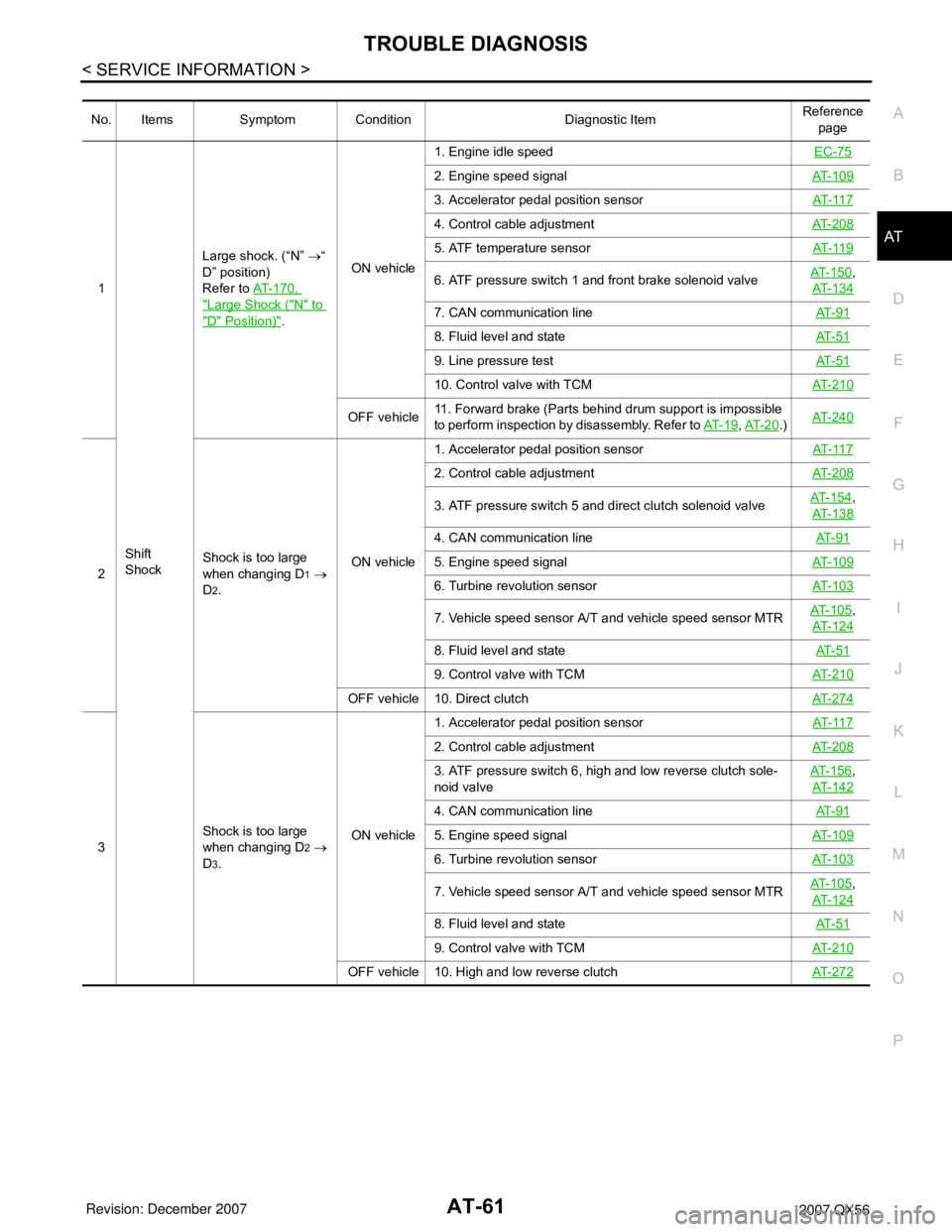
TROUBLE DIAGNOSIS
AT-61
< SERVICE INFORMATION >
D
E
F
G
H
I
J
K
L
MA
B
AT
N
O
P
No. Items Symptom Condition Diagnostic ItemReference
page
1
Shift
ShockLarge shock. (“N” →“
D” position)
Refer to AT- 1 7 0 ,
"Large Shock ("N" to
"D" Position)".ON vehicle1. Engine idle speedEC-75
2. Engine speed signalAT-109
3. Accelerator pedal position sensorAT- 11 7
4. Control cable adjustmentAT-208
5. ATF temperature sensorAT- 11 9
6. ATF pressure switch 1 and front brake solenoid valveAT- 1 5 0,
AT-134
7. CAN communication lineAT- 9 1
8. Fluid level and stateAT- 5 1
9. Line pressure testAT- 5 1
10. Control valve with TCMAT-210
OFF vehicle11. Forward brake (Parts behind drum support is impossible
to perform inspection by disassembly. Refer to AT- 1 9, AT- 2 0.)AT-240
2Shock is too large
when changing D1 →
D
2.ON vehicle1. Accelerator pedal position sensorAT- 11 7
2. Control cable adjustmentAT-208
3. ATF pressure switch 5 and direct clutch solenoid valveAT- 1 5 4,
AT-138
4. CAN communication lineAT- 9 1
5. Engine speed signalAT-109
6. Turbine revolution sensorAT-103
7. Vehicle speed sensor A/T and vehicle speed sensor MTRAT- 1 0 5,
AT-124
8. Fluid level and stateAT- 5 1
9. Control valve with TCMAT-210
OFF vehicle 10. Direct clutchAT-274
3Shock is too large
when changing D2 →
D
3.ON vehicle1. Accelerator pedal position sensorAT- 11 7
2. Control cable adjustmentAT-208
3. ATF pressure switch 6, high and low reverse clutch sole-
noid valveAT- 1 5 6,
AT-142
4. CAN communication lineAT- 9 1
5. Engine speed signalAT-109
6. Turbine revolution sensorAT-103
7. Vehicle speed sensor A/T and vehicle speed sensor MTRAT- 1 0 5,
AT-124
8. Fluid level and stateAT- 5 1
9. Control valve with TCMAT-210
OFF vehicle 10. High and low reverse clutchAT-272
Page 132 of 3061
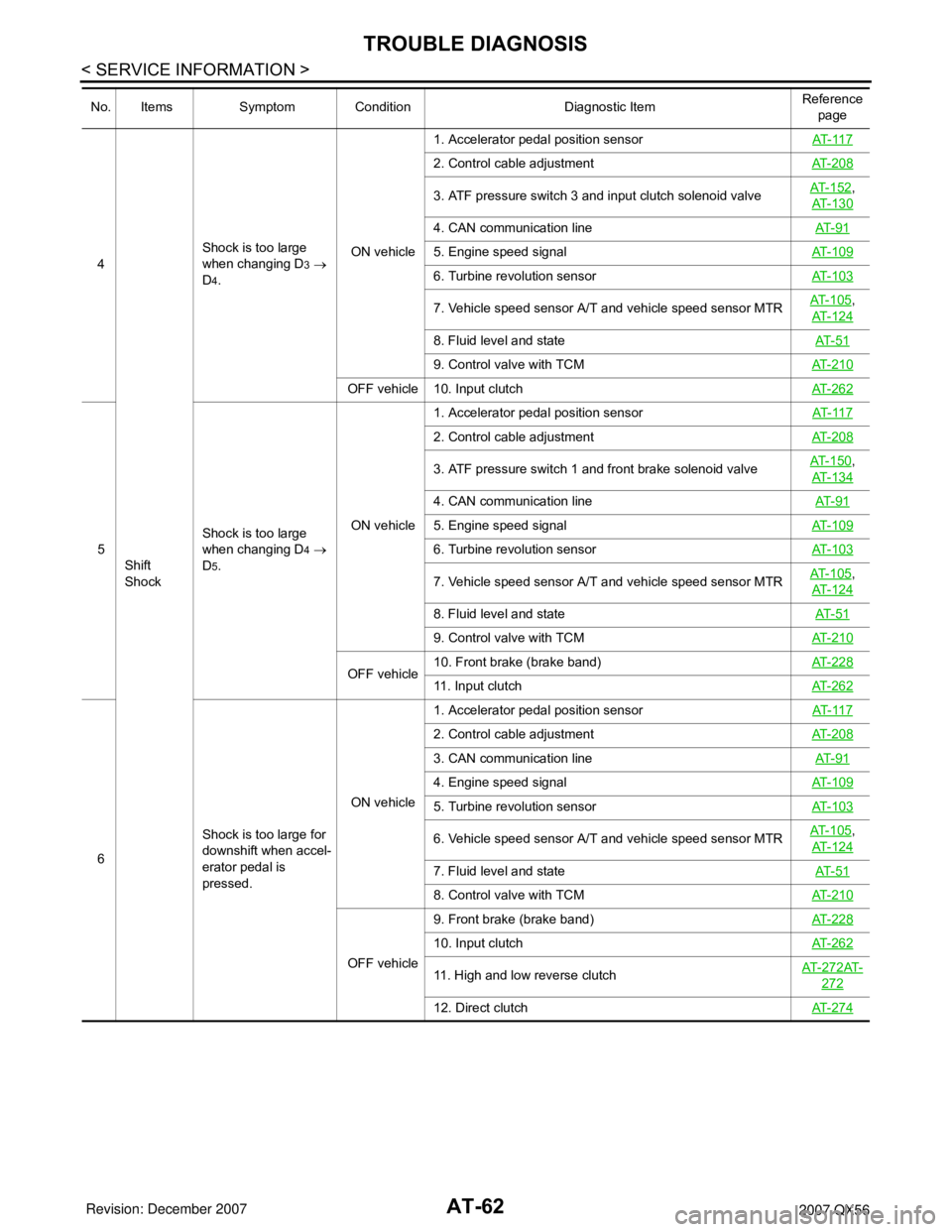
AT-62
< SERVICE INFORMATION >
TROUBLE DIAGNOSIS
4
Shift
ShockShock is too large
when changing D3 →
D
4.ON vehicle1. Accelerator pedal position sensorAT- 11 7
2. Control cable adjustmentAT- 2 0 8
3. ATF pressure switch 3 and input clutch solenoid valveAT- 1 5 2,
AT- 1 3 0
4. CAN communication lineAT- 9 1
5. Engine speed signalAT- 1 0 9
6. Turbine revolution sensorAT- 1 0 3
7. Vehicle speed sensor A/T and vehicle speed sensor MTRAT- 1 0 5,
AT- 1 2 4
8. Fluid level and stateAT- 5 1
9. Control valve with TCMAT- 2 1 0
OFF vehicle 10. Input clutchAT- 2 6 2
5Shock is too large
when changing D4 →
D
5.ON vehicle1. Accelerator pedal position sensorAT- 11 7
2. Control cable adjustmentAT- 2 0 8
3. ATF pressure switch 1 and front brake solenoid valveAT- 1 5 0,
AT- 1 3 4
4. CAN communication lineAT- 9 1
5. Engine speed signalAT- 1 0 9
6. Turbine revolution sensorAT- 1 0 3
7. Vehicle speed sensor A/T and vehicle speed sensor MTRAT- 1 0 5,
AT- 1 2 4
8. Fluid level and stateAT- 5 1
9. Control valve with TCMAT- 2 1 0
OFF vehicle10. Front brake (brake band)AT- 2 2 811. Input clutchAT- 2 6 2
6Shock is too large for
downshift when accel-
erator pedal is
pressed.ON vehicle1. Accelerator pedal position sensorAT- 11 7
2. Control cable adjustmentAT- 2 0 8
3. CAN communication lineAT- 9 1
4. Engine speed signalAT- 1 0 9
5. Turbine revolution sensorAT- 1 0 3
6. Vehicle speed sensor A/T and vehicle speed sensor MTRAT- 1 0 5,
AT- 1 2 4
7. Fluid level and stateAT- 5 1
8. Control valve with TCMAT- 2 1 0
OFF vehicle9. Front brake (brake band)AT- 2 2 8
10. Input clutchAT- 2 6 2
11. High and low reverse clutchAT- 2 7 2AT-
272
12. Direct clutchAT- 2 7 4
No. Items Symptom Condition Diagnostic ItemReference
page
Page 133 of 3061

TROUBLE DIAGNOSIS
AT-63
< SERVICE INFORMATION >
D
E
F
G
H
I
J
K
L
MA
B
AT
N
O
P
7
Shift
ShockShock is too large for
upshift when accelera-
tor pedal is released.ON vehicle1. Accelerator pedal position sensorAT- 11 7
2. Control cable adjustmentAT-208
3. Engine speed signalAT-109
4. CAN communication lineAT- 9 1
5. Turbine revolution sensorAT-103
6. Vehicle speed sensor A/T and vehicle speed sensor MTRAT- 1 0 5,
AT-124
7. Fluid level and stateAT- 5 1
8. Control valve with TCMAT-210
OFF vehicle9. Front brake (brake band)AT-22810. Input clutchAT-262
11. High and low reverse clutchAT-272
12. Direct clutchAT-274
8Shock is too large for
lock-up.ON vehicle1. Accelerator pedal position sensorAT- 11 7
2. Control cable adjustmentAT-208
3. Engine speed signalAT-109
4. CAN communication lineAT- 9 1
5. Turbine revolution sensorAT-103
6. Vehicle speed sensor A/T and vehicle speed sensor MTRAT- 1 0 5,
AT-124
7. Torque converter clutch solenoid valveAT- 111
8. Fluid level and stateAT- 5 1
9. Control valve with TCMAT-210
OFF vehicle 10. Torque converterAT-240
9Shock is too large dur-
ing engine brake.ON vehicle1. Accelerator pedal position sensorAT- 11 7
2. Control cable adjustmentAT-208
3. CAN communication lineAT- 9 1
4. Fluid level and stateAT- 5 1
5. Control valve with TCMAT-210
OFF vehicle6. Front brake (brake band)AT-2287. Input clutchAT-262
8. High and low reverse clutchAT-272
9. Direct clutchAT-274
No. Items Symptom Condition Diagnostic ItemReference
page
Page 134 of 3061
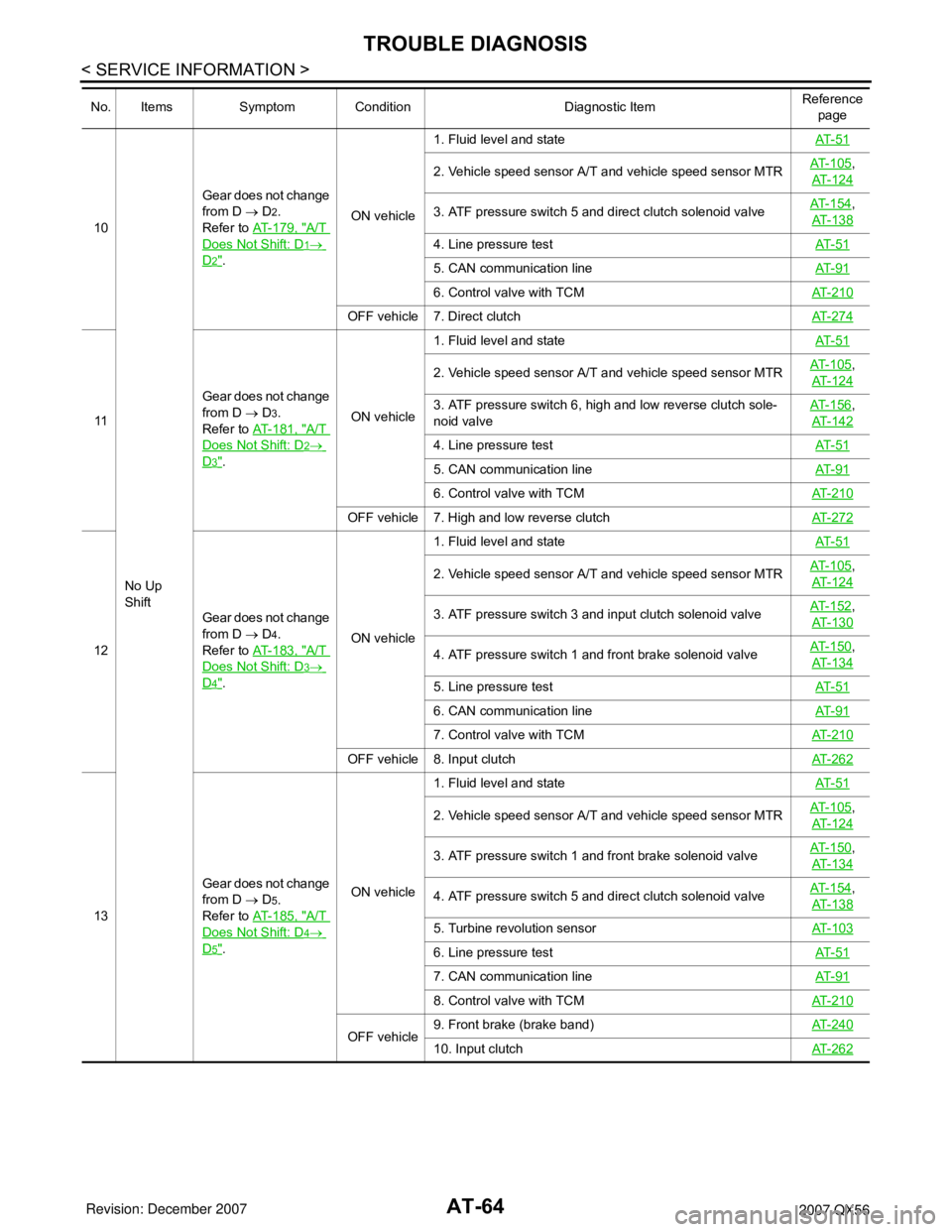
AT-64
< SERVICE INFORMATION >
TROUBLE DIAGNOSIS
10
No Up
ShiftGear does not change
from D → D
2.
Refer to AT-179, "
A/T
Does Not Shift: D1→
D2".ON vehicle1. Fluid level and stateAT- 5 1
2. Vehicle speed sensor A/T and vehicle speed sensor MTRAT- 1 0 5,
AT- 1 2 4
3. ATF pressure switch 5 and direct clutch solenoid valveAT- 1 5 4,
AT- 1 3 8
4. Line pressure testAT- 5 1
5. CAN communication lineAT- 9 1
6. Control valve with TCMAT- 2 1 0
OFF vehicle 7. Direct clutchAT- 2 7 4
11Gear does not change
from D → D3.
Refer to AT-181, "
A/T
Does Not Shift: D2→
D3".ON vehicle1. Fluid level and stateAT- 5 1
2. Vehicle speed sensor A/T and vehicle speed sensor MTRAT- 1 0 5,
AT- 1 2 4
3. ATF pressure switch 6, high and low reverse clutch sole-
noid valveAT- 1 5 6,
AT- 1 4 2
4. Line pressure testAT- 5 1
5. CAN communication lineAT- 9 1
6. Control valve with TCMAT- 2 1 0
OFF vehicle 7. High and low reverse clutchAT- 2 7 2
12Gear does not change
from D → D
4.
Refer to AT-183, "
A/T
Does Not Shift: D3→
D4".ON vehicle1. Fluid level and stateAT- 5 1
2. Vehicle speed sensor A/T and vehicle speed sensor MTRAT- 1 0 5,
AT- 1 2 4
3. ATF pressure switch 3 and input clutch solenoid valveAT- 1 5 2,
AT- 1 3 0
4. ATF pressure switch 1 and front brake solenoid valveAT- 1 5 0,
AT- 1 3 4
5. Line pressure testAT- 5 1
6. CAN communication lineAT- 9 1
7. Control valve with TCMAT- 2 1 0
OFF vehicle 8. Input clutchAT- 2 6 2
13Gear does not change
from D → D
5.
Refer to AT-185, "
A/T
Does Not Shift: D4→
D5".ON vehicle1. Fluid level and stateAT- 5 1
2. Vehicle speed sensor A/T and vehicle speed sensor MTRAT- 1 0 5,
AT- 1 2 4
3. ATF pressure switch 1 and front brake solenoid valveAT- 1 5 0,
AT- 1 3 4
4. ATF pressure switch 5 and direct clutch solenoid valveAT- 1 5 4,
AT- 1 3 8
5. Turbine revolution sensorAT- 1 0 3
6. Line pressure testAT- 5 1
7. CAN communication lineAT- 9 1
8. Control valve with TCMAT- 2 1 0
OFF vehicle9. Front brake (brake band)AT- 2 4 010. Input clutchAT- 2 6 2
No. Items Symptom Condition Diagnostic ItemReference
page
Page 135 of 3061
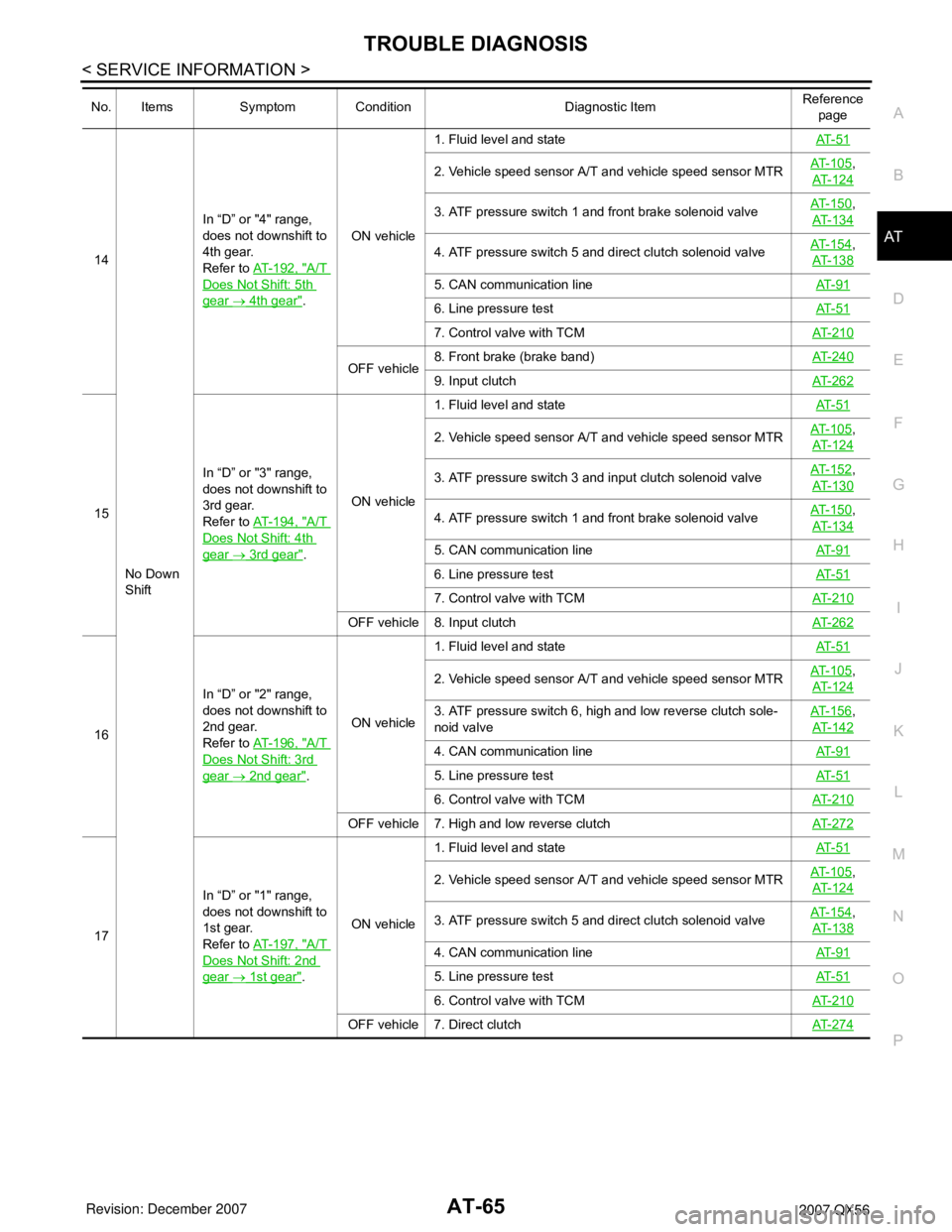
TROUBLE DIAGNOSIS
AT-65
< SERVICE INFORMATION >
D
E
F
G
H
I
J
K
L
MA
B
AT
N
O
P
14
No Down
ShiftIn “D” or "4" range,
does not downshift to
4th gear.
Refer to AT- 1 9 2 , "A/T
Does Not Shift: 5th
gear → 4th gear".ON vehicle1. Fluid level and stateAT- 5 1
2. Vehicle speed sensor A/T and vehicle speed sensor MTRAT- 1 0 5,
AT-124
3. ATF pressure switch 1 and front brake solenoid valveAT- 1 5 0
,
AT-134
4. ATF pressure switch 5 and direct clutch solenoid valveAT- 1 5 4,
AT-138
5. CAN communication lineAT- 9 1
6. Line pressure testAT- 5 1
7. Control valve with TCMAT-210
OFF vehicle8. Front brake (brake band)AT-2409. Input clutchAT-262
15In “D” or "3" range,
does not downshift to
3rd gear.
Refer to AT- 1 9 4 , "A/T
Does Not Shift: 4th
gear → 3rd gear".ON vehicle1. Fluid level and stateAT- 5 1
2. Vehicle speed sensor A/T and vehicle speed sensor MTRAT- 1 0 5,
AT-124
3. ATF pressure switch 3 and input clutch solenoid valveAT- 1 5 2,
AT-130
4. ATF pressure switch 1 and front brake solenoid valveAT- 1 5 0,
AT-134
5. CAN communication lineAT- 9 1
6. Line pressure testAT- 5 1
7. Control valve with TCMAT-210
OFF vehicle 8. Input clutchAT-262
16In “D” or "2" range,
does not downshift to
2nd gear.
Refer to AT- 1 9 6 , "A/T
Does Not Shift: 3rd
gear → 2nd gear".ON vehicle1. Fluid level and stateAT- 5 1
2. Vehicle speed sensor A/T and vehicle speed sensor MTRAT- 1 0 5,
AT-124
3. ATF pressure switch 6, high and low reverse clutch sole-
noid valveAT- 1 5 6
,
AT-142
4. CAN communication lineAT- 9 1
5. Line pressure testAT- 5 1
6. Control valve with TCMAT-210
OFF vehicle 7. High and low reverse clutchAT-272
17In “D” or "1" range,
does not downshift to
1st gear.
Refer to AT- 1 9 7 , "A/T
Does Not Shift: 2nd
gear → 1st gear".ON vehicle1. Fluid level and stateAT- 5 1
2. Vehicle speed sensor A/T and vehicle speed sensor MTRAT- 1 0 5,
AT-124
3. ATF pressure switch 5 and direct clutch solenoid valveAT- 1 5 4,
AT-138
4. CAN communication lineAT- 9 1
5. Line pressure testAT- 5 1
6. Control valve with TCMAT-210
OFF vehicle 7. Direct clutchAT-274
No. Items Symptom Condition Diagnostic ItemReference
page
Page 136 of 3061
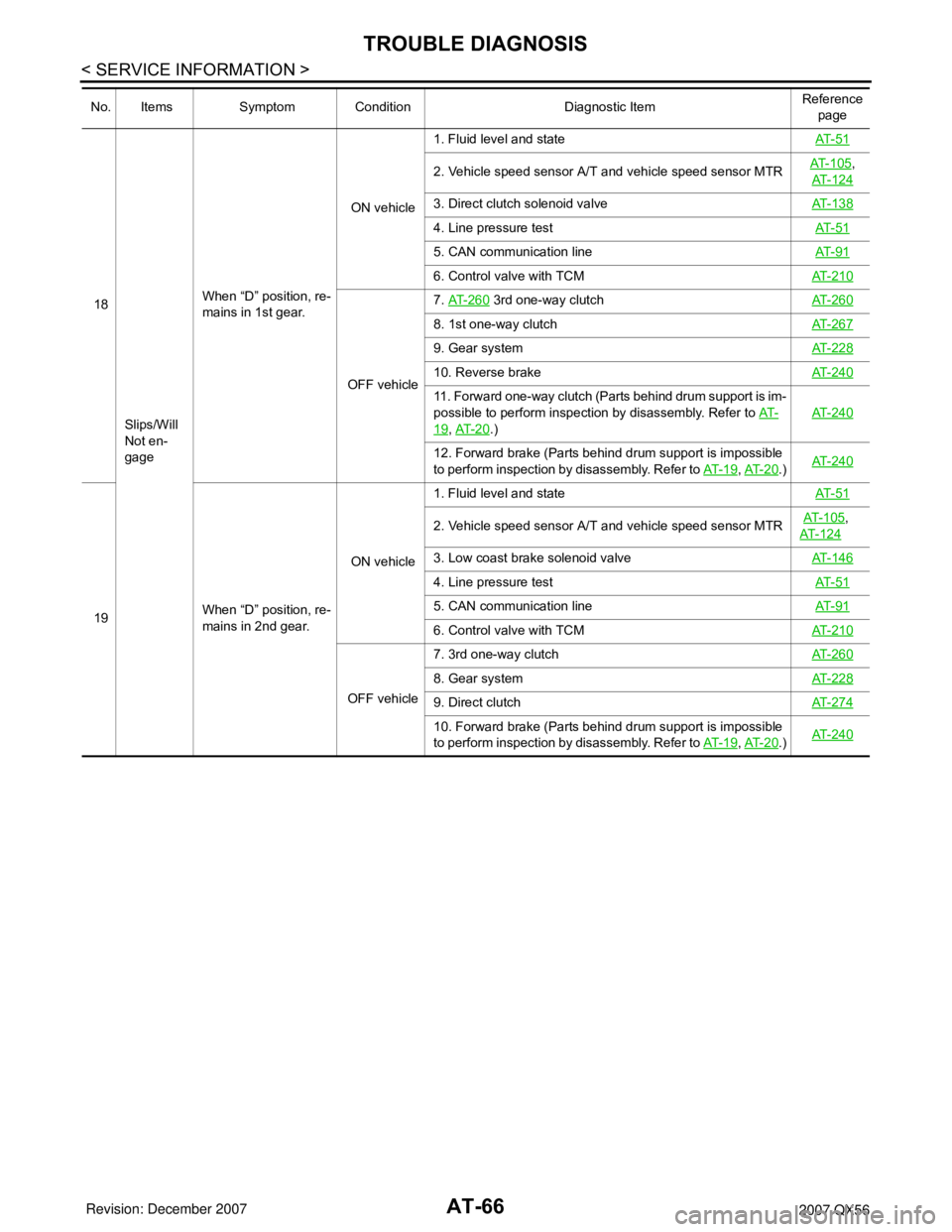
AT-66
< SERVICE INFORMATION >
TROUBLE DIAGNOSIS
18
Slips/Will
Not en-
gageWhen “D” position, re-
mains in 1st gear.ON vehicle1. Fluid level and stateAT- 5 1
2. Vehicle speed sensor A/T and vehicle speed sensor MTRAT- 1 0 5,
AT- 1 2 4
3. Direct clutch solenoid valveAT- 1 3 8
4. Line pressure testAT- 5 1
5. CAN communication lineAT- 9 1
6. Control valve with TCMAT- 2 1 0
OFF vehicle7. AT- 2 6 0
3rd one-way clutchAT- 2 6 0
8. 1st one-way clutchAT- 2 6 7
9. Gear systemAT- 2 2 8
10. Reverse brakeAT- 2 4 0
11. Forward one-way clutch (Parts behind drum support is im-
possible to perform inspection by disassembly. Refer to AT-
19, AT- 2 0.)AT- 2 4 0
12. Forward brake (Parts behind drum support is impossible
to perform inspection by disassembly. Refer to AT- 1 9
, AT- 2 0.)AT- 2 4 0
19When “D” position, re-
mains in 2nd gear.ON vehicle1. Fluid level and stateAT- 5 1
2. Vehicle speed sensor A/T and vehicle speed sensor MTR AT- 1 0 5,
AT- 1 2 4
3. Low coast brake solenoid valveAT- 1 4 6
4. Line pressure testAT- 5 1
5. CAN communication lineAT- 9 1
6. Control valve with TCMAT- 2 1 0
OFF vehicle7. 3rd one-way clutchAT- 2 6 0
8. Gear systemAT- 2 2 8
9. Direct clutchAT- 2 7 4
10. Forward brake (Parts behind drum support is impossible
to perform inspection by disassembly. Refer to AT- 1 9
, AT- 2 0.)AT- 2 4 0
No. Items Symptom Condition Diagnostic ItemReference
page